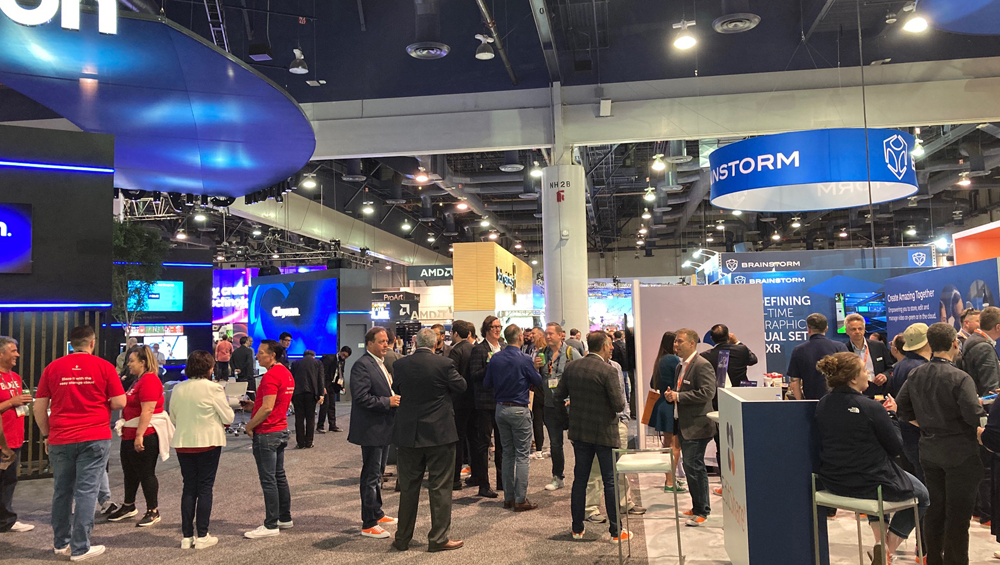
A Smaller NAB Show, But More Energized

The first NAB Show in three years may have been smaller than previous editions, but the broadcasters and technology vendors who gathered in Las Vegas this week were happy to be meeting in person again. And with so much change occurring in the broadcast business throughout the pandemic, including a shift to remote production and an explosion in streaming services, the energy of NAB 2022 suggested that a large in-person trade show can still play a valuable role in helping broadcasters keep pace.
Sinclair Broadcast Group was one of several big station groups that made the trip to Las Vegas, where it demonstrated various technology initiatives including a method for converting standard dynamic range content to high dynamic range (HDR) and a new ATSC 3.0 broadcast app it has developed and is making freely available to stations launching NextGen TV broadcasts. Sinclair’s contingent was led by President and CEO Chris Ripley, who described his emphasis on technology with Devoncroft Partners principal analyst Josh Stinehour at the Devoncroft Executive Summit on Saturday.
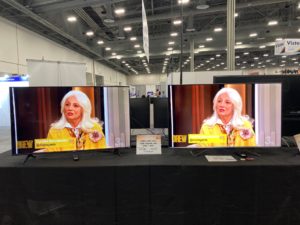
In the Ultra HD Forum display, one could see Sinclair’s method of converting SDR content (left) to HDR using technology from Technicolor and InterDigital.
“I think in today’s age, almost every company is becoming a technology company, and that is especially true in media,” Ripley said. “There is no part of what we do in media that is not touched by technology. As a leader, you have got to understand it. You don’t have to understand how to do it, but you have to understand what it does, and you have to understand what it does very precisely. So, I spend a lot of time with the team understanding what the capabilities of the various technologies are, and how do those compare to the competitive set?”
Paramount Global sent several top executives to the show including CTO Phil Wiser, who spoke at Devoncroft, and VP and Head of Global Production Technology Josh Limor, who explained Paramount’s “cloud-first” production strategy on the floor of the new West Hall of the Las Vegas Convention Center on Monday alongside Avid VP Craig Dwyer (Avid didn’t exhibit this year but did send several executives for meetings). Limor noted the smaller crowd, but said he was enjoying the show.
“I think it’s great that people are getting back together and having face-to-face conversations,” Limor said.
Vendors Get Their Money’s Worth
According to NAB, registered attendance this year was 52,468, representing over a 40% drop from the 91,921 attendees in 2019. International attendance was pegged at 11,542. Those numbers are subject to change after a final audit, and most vendors this reporter spoke with estimated actual attendance to be closer to 40,000. But those same vendors unanimously said the show was a worthwhile investment, both in the general flow of traffic in their booths and the number of meetings they had with senior-level executives.
“We definitely have gotten our money’s worth out of this show,” said Imagine Communications President Steve Reynolds, who estimated attendance was in the 30,000 to 35,000 range based on the length of the taxi lines.
Reynolds said that Imagine had enjoyed “great traffic” in its Central Hall booth and that its customer contacts and meetings were “very high quality. What seems to have happened with the buying side is that people had to prequalify why they were going to NAB,” Reynolds said. “So, most of the people we’re talking to are people who are here to buy something. There doesn’t seem to be a lot of casual people just walking around and surveying what’s new.”
Gazing West
After visiting the new West Hall, Reynolds was impressed with its appearance but found the crowd there to be “kind of light,” particularly once one got past Amazon Web Services (AWS) and other cloud companies in the first third of the hall. That was a point echoed by several exhibitors in West.
Per Johansson, head of sales, Americas for Net Insight, said his company had enjoyed good meetings at its West Hall booth but found the overall environment to be a bit sleepy compared to its former location in South Upper. He envied the traffic he had seen in Central Hall.
“That is more of an NAB hall,” Johansson said. “This is more of a vacation hall.”
With only 900-plus exhibitors this year compared to 1,632 exhibitors in 2019, several vendors suggested that NAB could have consolidated the show into the Central and North Halls or even squeezed everyone into the new space in West. All attendees this reporter spoke with agreed that walking to the back of West from Central was as far, if not farther, than the trek to the rear of South in the past.
Reynolds said consolidating into two halls would have been feasible but empathized with the planning challenges NAB faced given vendors’ uncertainty due to COVID. He said Imagine itself didn’t commit to attending until after Christmas.
“I think some people did pull out, and I’m basing that on the fact that there are empty pods,” Reynolds said. “There are 40’x40’ spaces out here on the floor that clearly should have had something in them. With the uncertainty of the pandemic, I think the NAB guys did as good a job as they possibly could have planning around that uncertainty.”
Smaller Vendor Teams
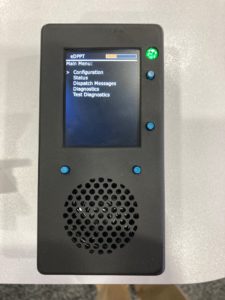
The 3.0-enabled pagers being used by first responders in North Carolina through a partnership with PBS North Carolina.
In 2019 Ross Video occupied a large space in South, which NAB is no longer using. With the uncertainties of COVID, it was tough for Ross to commit to a big space back in January when the company had to firm up plans, said Shawn Snider, VP of production workflows and cloud services for Ross Video. Considering the global supply chain issues impacting its manufacturing, Ross also didn’t feel it was smart to be making products aimed at the show floor instead of shipping them to customers.
So, this week Ross was in a much smaller footprint in the North Hall. The company took a different approach to its exhibition, focusing more on providing meeting space than demonstrating a lot of equipment. While once Ross rolled three transport trucks full of gear to Las Vegas, this year it brought only one. And instead of 200 people, the company brought about 80 this year.
But Snider said the company was happy it made the trip.
“It’s been incredibly busy,” he said. “Way more than we expected.”
Like Reynolds, Snider said customers had significantly cut back on the number of staffers they were sending compared to previous years, when station groups might send a representative from each station.
“This year it’s a team of three, instead of 20,” he said.
Several vendors suggested that the smaller show, which was more in the range of a typical IBC convention in Amsterdam, allowed them to conduct business on a more productive level.
“The lower density allows for higher quality communications, without the noise factor of a typical show,” said Matt Herren, senior director of sales for video quality measurement firm SSIMWAVE, which was exhibiting in West.
Cloud Wave Continues
The continued shift of broadcast workflows to the public cloud was evident in technology announcements at NAB from legacy vendors like Grass Valley, Sony, Imagine and Ross.
Grass Valley has been promoting its Advanced Media Processing Platform (AMPP) software as a tool for cloud-based production for several years, and at NAB introduced several enhancements to AMPP including fully integrated asset management, browser-based editing and video replay capabilities. The company also announced a new multi-year agreement with AWS to work together to develop cloud solutions and highlighted strategic partnerships aimed at the cloud with Epic Games, creator of the Unreal Engine rendering system popular for virtual sets and virtual production, and Diversified, the leading systems integrator.
Grass Valley also announced that it will no longer charge for playout through AMPP starting in June, and that AMPP will now offer full support for the popular NDI video-over-IP networking protocol. The NDI announcement makes immediate sense, as new Grass Valley CEO Andrew Cross invented NDI while at NewTek, where he rose to CEO before it was acquired by Vizrt in 2019. Cross said that while NDI has gained traction with broadcasters it wasn’t designed for their use and thus doesn’t offer things like native closed-captioning support. Grass Valley integrating NDI into AMPP can help solve those types of problems.
As for the playout announcement, Cross noted that GV has enjoyed a dominant position in legacy video server hardware for playout. But it isn’t looking to pursue the same business model in the cloud, which he said was a logical place for playout to migrate to.
“We see a huge number of companies that have taken what was a server, and they’ve moved it into the cloud and attached a similar business model to it, where you charge per channel,” Cross. said “What we say is, you know that should be a core part of what a cloud service should offer, is the ability to play media clips. So, let’s not charge for that piece.”
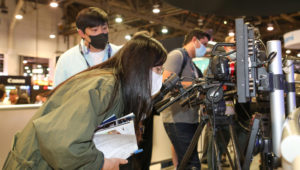 Ross’ big product introduction was the “Ross Production Cloud,” a full end-to-end production workflow designed to run on AWS that includes production switching, real-time graphics, ingest, playout, newsroom, asset management and remote contribution capabilities. (Snider said Ross was also working on expanding it to the Google Cloud and Microsoft Azure platforms).
Ross’ big product introduction was the “Ross Production Cloud,” a full end-to-end production workflow designed to run on AWS that includes production switching, real-time graphics, ingest, playout, newsroom, asset management and remote contribution capabilities. (Snider said Ross was also working on expanding it to the Google Cloud and Microsoft Azure platforms).
In contrast to some other vendors, Ross won’t be selling Production Cloud in a Software as a Service (SaaS) model but will instead be offering the software on a subscription or perpetual license basis with customers contracting directly with AWS for their compute. Snider said that was based on customer requests, as some who already do a lot of business with AWS can get better pricing for compute based on their overall volume of usage. Security is also paramount to broadcasters and so many want to manage their relationship with cloud vendors directly.
Imagine unveiled two major new cloud products. The first, Aviator, is a new orchestration console for planning, making and monetizing content through the AWS cloud that ties together several capabilities that were already in the Imagine portfolio, such as rights management and digital ad insertion. The second product introduction, SureFire, is a video ad server for FAST channels that is designed to bring broadcast-grade features to digital distribution, avoiding snafus like the same spot running back-to-back.
“We took all of the business rules from the traditional linear side of the business, such as category separation, clash rules and time-of-day restrictions, and translated that into the digital space,” Reynolds said. “From the advertiser or agency point of view now, they can buy digital ad campaigns that have the same quality as broadcast ad campaigns.”
NextGen TV Progress
Reynolds said the core SureFire technology could also be used to deliver targeted ads with ATSC 3.0 broadcasts, something which he expects to see happen later this year. With 59 markets now on-air with 3.0, or NextGen TV, monetizing the new standard is now top of mind for broadcasters, both from a revenue and stock valuation standpoint.
“It is challenging from a Wall Street perspective because media and broadcasting is a traditional business, it’s generally viewed as a value business on Wall Street, and embedded in this value business is this incredible growth asset, NextGen [TV],” said Sinclair’s Ripley. “NextGen is going to transform the industry — we actually believe there will be a day when it’s more profitable to send a bit of data than to use that bit to transmit affiliate content, which is a pretty big statement when you consider that we make a lot of money sending over-the-air, Big Four affiliate content. But we are pursuing this because we know one day that will flip.”
Sinclair made news heading into NAB by unveiling a datacasting pilot with digital signage provider USSI Global in which 3.0 spectrum will be used to deliver local content, advertising and data files to electric vehicle (EV) charging stations. And in a hotel suite at the Wynn this week, BitPath, the joint venture of Sinclair and Nexstar aimed at finding nontraditional applications for the 3.0 spectrum, was demonstrating how 3.0 signals can be used to improve location services by offering a second data source to oft-inaccurate GPS data.
The proposed service, called NavPath, uses a “base station” with a highly precise location and mobile “rovers” that receive robust 3.0 signals and whose location data can be cross-checked against GPS data, which varies daily due to atmospheric conditions and other factors. BitPath is currently field-testing the system in Washington and sees potential customers as utility companies and other industrial users.
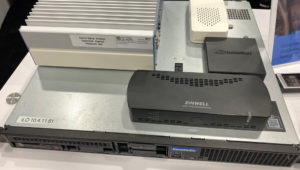
Various 3.0 datacasting receivers at the Triveni Digital booth.
Broadcasters also hope to generate additional revenues with NextGen TV by delivering targeted advertising and interactive or personalized content to viewers’ TVs through the broadband pipe. Those use cases could be seen in the ATSC booth at NAB in the form of two broadcast apps designed to work on any NextGen TV set. One called Run3TV has been developed by the Pearl TV coalition, and the other by Sinclair. Both take on the shape of “L-bar” graphic overlay atop the standard broadcast video with clickable buttons for additional on-demand content that can be delivered through the internet, including targeted advertising or promotional content.
With over 80% of viewers watching their local stations through cable or satellite providers, broadcasters have been worried about the 3.0 app getting stripped out of the signal either through the distribution chain or when passing between a set-top and the TV over an HDMI cable. They got some good news this week with an announcement from watermarking specialist Verance that it had reached a deal with set-maker LG Electronics to include its Aspect watermark technology in LG’s NextGen TV sets.
This spring, dozens of 2022 and 2021 LG NextGen TV models will receive a firmware update allowing them to detect Verance Aspect, a commercial implementation of the ATSC A/334 audio watermark standard that is easily inserted into the 3.0 signal at the station. By including the Aspect watermark in the broadcast signal and allowing LG TVs to detect it, interactive 3.0 data like Sinclair’s new broadcast app won’t be stripped out when passing through a set-top box and the app will still work even if the viewer is watching their broadcast content through a cable or satellite provider instead of over-the-air.
“Anyone with a cable or satellite subscription, they can still tune into the interactive content,” said Jason Patton, Verance SVP of sales and marketing.




































Comments (0)